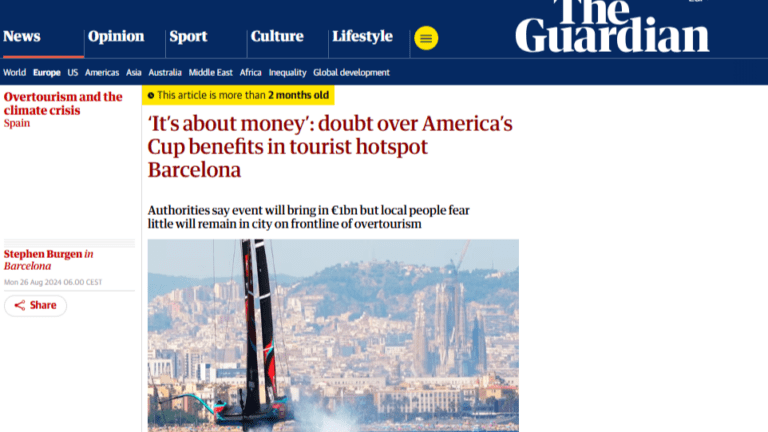Jacquemus The Blueprint for Modern Brand Success
How Jacquemus built a €200M brand with founder-led storytelling, sensory retail, and Provence-rooted authenticity. A masterclass in modern brand strategy.

Anti-tourism protests swept across Europe this summer, with demonstrations taking place in the Netherlands, Greece, and Spain. In 2021 Venetians along with UNESCO were central in banning cruise ships entering the historic centre of Venice.
However as far as I know the protesters who marched in July in Barcelona spraying unsuspecting visitors with water pistols while chanting “Tourists go home” were the first to reference a major event as a cause. The America’s Cup drew criticism over its perceived benefits, with concerns about over-tourism and its impact on local communities dominating the narrative.
In the same way, major sports events are a beacon for positive change, they risk being a rallying point for protest. Effective storytelling that connects the economic impact of the events directly to residents’ lives would go a long way to heading off concerns.
First major sports events aren’t very different to cruise passengers. Our recent work in Oman shows they spend nearly $500 a day in the community they visit – taxis, hotels, flights, F&B etc. but making that come to life is key. Barcelona talked a lot about the €1bn+ economic upside of SailGP in the city. These sorts of numbers are useful to city leaders. It gives them the method to measure both the event and whether they are doing their job well but mean little to local people.
We should be breaking this down into tangible benefits for local workers and Developing Local Economic Stories (LES). This is marketing 101 – make yourself relevant to the audience.
How? From the models we create, we know that in Western Europe about 53% of the net economic upside from an event drops into the Wages and Pensions bucket. We also know how much of the money is spent on hotels, restaurants, and transport and how that translates into take-home pay.
For instance, in the SailGP models we recently did for a Middle Eastern host nation, we highlighted stories and created content that brings the economic data to life as a story before during and after the event. E.g. Maryam, a local caterer, who would see her bookings triple during the event, or Kareem, a taxi driver whose earnings would rise by 30%.
Making it human in scale and creating tailored stories featuring testimonials from small business owners, workers, and suppliers make these LESs personal, vivid, and hard to dismiss.
Feeding the government tax monster holds little interest for the public but public services most certainly do.
Of the €1bn economic upside the America’s Cup created we know that (in Western Europe) about 30% of the net economic upside goes to taxes. €300m is the cost of a new hospital or pays for 40,000 primary school kids’ education at an average per-pupil p.a. funding of €7,400.
Highlighting how taxes generated from event spending are reinvested into local services, such as public schools, public transportation, and infrastructure, can be very impactful. This message becomes even stronger when presented in a personal and vivid manner that is difficult to dismiss. When creating media campaigns that involve taking athletes to local schools, it’s important to include these types of statistics to effectively communicate the economic benefits to a different audience. This approach is complementary to the inspiring and high-achieving sports message that normally resonates.
Create data visualisations showing where the money flows—hotels, transport, retail—and the ripple effect on jobs and local wages. For instance, map out €500m going to hotel staff wages, €200m to restaurants, and €100m to transportation. Clear, engaging visuals that connect abstract numbers to real-life impacts.
We have developed scalable tools that can be localised city by city. So, a Barcelona-specific template can serve as a model for other host cities for future events to build media kits that journalists can easily use, complete with visuals, data points, and quotes from local workers. Align Emotion with Data – Marry the emotional power of individual stories with data-driven evidence: Start with Maryama, Juan or Joe and the events catering services. End with statistics showing the wider €1bn+ economic benefit for the city.
This approach resonates because it centres on real people and relatable impacts, shifting the focus from abstract ‘benefits’ to how those benefits touch everyday lives.
For sports organisations it’s marketing 101: make the story relevant to the audience. The audience used to be politicians and investors. They are still there but they have been joined by the activist public. It’s about measuring, and packaging the data into personal, vivid, and hard to dismiss narratives that inspire pride, confidence, and trust. By doing so, events can turn critics into advocates, showcasing how events are contributing to a better future.
How Jacquemus built a €200M brand with founder-led storytelling, sensory retail, and Provence-rooted authenticity. A masterclass in modern brand strategy.
TAG Heuer F1 Partnership. TAG returns as F1’s timekeeper - $1B deal. Can it sustain growth in a slowing market? We analyse the…
Discover how luxury watchmaker Vanguart is redefining haute horology through scarcity, innovation, and cultural relevance.

